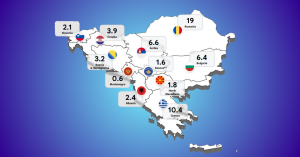In times when Venture Capital is seen as a must in the startup world, loan financing, and banking sound…well, traditional. Banking, which has always been focused on corporations up until now, also has its advantages. In order to extend banking to SMEs and scale-ups, Raiffeisen Bank International (RBI) and its Digital Department have developed a scale-up loan financing program called The Digital Basket. With a total volume of €100M, it is one of the biggest European financing programs for digital growth companies.
The Recursive talked to Joerg Bartussek, Head of Digital Customers at RBI, and a professional with more than 20 years of experience in the digital economy and banking. He’s also a fintech specialist who has founded and exited a scale-up. He explained in detail what are the benefits of traditional financing for founders, how the new Digital Basket Program works, and how he imagines the future of banking.
Between VC rounds and bank loans
Joerg Bartussek came up with the idea for his own startup, the crowdinvesting fintech Finnest platform when he and his co-founder identified a gap in the SMEs financing market. It was the case that well-established mid-sized companies were partly under-banked as they couldn’t get the loans at the terms they needed. Unlike big corporations with large revenue, when applying for loans, such scaling companies could not present to banks historical financial data with billions of yearly revenue.
Nevertheless, many SMEs were experiencing steady growth, had recurring and increasing revenues and positive ratings. So, when they were looking for ways to finance their expansion, the only option available was to give away some of their equity to VCs, private equity, and business angel investors. “With every financing round when you bring in VCs you lose shares of your own company and, in the end, there is only 100%. Referring to my experience with Finnest, in the beginning, we were three co-founders – each of us had 33.3% equity. Suddenly, after a few financing rounds, I found myself close to single-digit shares and that is not very motivating” he remembers.
So the shares were slowly running out, Finnest was making money and needed more capital to grow. It was then when Bartussek decided that he would rather avoid giving more shares of his company to VCs and would instead seek to finance growth through a simple bank loan. In 2017 and 2018 he went to banks all over Austria and Germany only to find that none of them gives loans to scaling digital companies.
Being a founder himself, Bartussek has been in the situation of the entrepreneurs he is trying to help. As a Head of Digital Customers at RBI, he’s applying the same two criteria – the product-market fit and the existence of an underbanked industry segment. He has started the €100M Digital Basket debt financing program for scaling SMEs that wish to finance growth without the help of VCs.

Who is the Digital Basket loan for?
“At RBI, we built the perfect product for this underserved market – a traditional and simple corporate loan. We give scale-ups between €1M and €7M, they pay the money back with 5-10% interest rates on top. This means that with a total of €100M we can finance around 20 SMEs if the average size is around €5M. There aren’t any upfront fees, no equity kickers, and no hidden costs”, Bartussek explained. The debt financing program targets digital scale-ups from Western, Central, or Eastern Europe coming from all industries except fintech because RBI has a different project that is solely fintech-oriented – the Elevator Lab. In order to qualify for the loan, the SMEs should also have annual revenue of above €5M and should have already raised more than €3M in equity. Lastly, applicants should be able to present positive gross margins and a growing customer base in at least 2 markets.
With a size ranging between €1M and €7M, the Digital Basket loan has a maturity of 1 to 5 years, it calculates interest based on the scale-up’s rating, and allows early repayment without taking any equity.
“Additionally, Western European VCs do not usually have scale-ups from the SEE region on their radar and even when they do, they tend to be very risk-averse. And that is why RBI, which is present in 13 Eastern European countries and knows the local markets very well, is good at assessing risk and identifying strong business potential,” Bartussek argues.
SMEs financing from the perspective of bankers
Bartussek explains that with the Digital Basket program, RBI is doing for SMEs what it is normally doing for its large corporate customers, and is now extending its offerings to this new market segment to meet the demands.
The Head of Digital Customers at RBI elaborates that traditionally banks give loans to large corporations that have an annual turnover of at least €0.5B The reason for that is bankers feel comfortable with such business models, they know how to assess the economic situation and how various ecosystem factors affect these corporations.. “It is normal that there is a lot of skepticism in the bank when we talk about scale-ups financing because it is considered risky. And as bankers, we know that statistically, 9 out of 10 early-stage startups fail, and by the authority, we are not allowed to finance such risky ventures. That is why we go to the next segment and have the €5M minimum revenue criteria,” Bartussek says.
When it comes to the evaluation of the SMEs applying for a loan, he explains that RBI follows the exact same processes it has for its corporate clients – the Anti-Money-Laundering (AML) and the Know-Your-Customer (KYC) processes. The scale-ups are then given a rating, which is the normal rating that is also applied to global corporate leaders. Based on that rating, the bank sets the interest rate for the loan. The difference in the case of the Digital Basket Program is that bankers calibrate the rating system to make it fit the stage of development of SMEs.
“Most of the scaling companies are not EBIT positive, to give an example. They can earn a lot of money but they immediately spend it on marketing, software development, and personnel. We understand that for this market that is usually the rule. Taking into account their high costs, our model can still calculate if they can pay back,” Bartussek says.
The future of banking
Talking about how banks will operate in the future, Bartussek outlines that all the processes that make sense to be automated will be automated. But he believes that in corporate banking and investment banking, the human element will always remain. “10 years ago the ratio was 90% Human and 10% Digital. In the future, this might turn around completely but it still does not mean that there will be no more human element in assessing, talking, and building relationships with clients. So I think the banks that manage this digital-personal mix the best will be the winners,” he exemplifies.
Another trend he’s watching is the digitalization and the increasing use of APIs and open banking. This means that banks will make more connections of their internal banking systems with customers’ banking systems. Bartussek says that the banks which manage to make the digital experience of their clients nicer will gain a competitive advantage. “This is also connected to the trend of mass-customization because if one feature, user interface, or an API connection fits one customer, it doesn’t mean that this is perfect for another customer. That is why I believe that banks will develop a portfolio of features that they can tailor for each client to create the perfect interaction on a mass scale”, he concludes.







